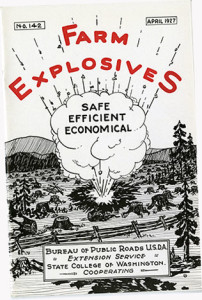By Nella Letizia, WSU Libraries
 PULLMAN, Wash. – For today’s information seekers, who can find answers in minutes with a few keystrokes, it’s hard to imagine a time when rural dwellers were cut off from knowledge for the most fundamental reasons. No electricity. No car. No phone. No nearby expert to explain why a cow gave birth to her calf prematurely.
PULLMAN, Wash. – For today’s information seekers, who can find answers in minutes with a few keystrokes, it’s hard to imagine a time when rural dwellers were cut off from knowledge for the most fundamental reasons. No electricity. No car. No phone. No nearby expert to explain why a cow gave birth to her calf prematurely.

Such was the information landscape for farmers and homemakers in Washington at the turn of the century. The state’s Extension Service – working closely with the fledgling State College of Washington – sought to fill the void by publishing documents rural citizens could hold in their hands and dog-ear over repeated readings for reference: Extension Bulletins.
As the nation approaches the centennial anniversary of the May 8, 1914, Smith-Lever Act – which created the U.S. Cooperative Extension Service – Washington State University’s Manuscripts, Archives and Special Collections (MASC) is digitizing a century of Washington Extension’s written expertise in a new collection, “Extension Bulletin Archives” (http://content.libraries.wsu.edu
/cdm/landingpage/collection/ext).
Making the digital leap
One of the project’s supervisors, WSU Libraries’ metadata librarian Greg Matthews, has cataloged the university’s bulletins for many years. He said cataloging every issue (and related publications) has been a longstanding ambition for the libraries.
But it wasn’t until WSU Libraries received financial support from the U.S. Agricultural Information Network’s Preservation and Digital Library Committee that MASC could make the bulletins accessible electronically.
“In the past, access to these items was primarily limited to searching for them in library catalogs and browsing print issues on the shelves,” Matthews said. “By digitizing the Extension Bulletins, readers and researchers can now access this content through widely available online tools such as Google.”
A whole different world

Before the future WSU published the first bulletin in 1913 – “Growing Alfalfa without Irrigation” – farmers around the state came to Pullman to learn about cutting-edge information useful to their operations, said Mark O’English, university archivist and project supervisor. Traveling demonstration trains and instructional Farmers’ Institutes also brought experts to farmers to share their research.
But those early efforts were expensive and difficult, given that farmers often traveled by horse and wagon and winter weather could be treacherous. The state created its own Extension Service in 1913 (a year before the national service) and released the first bulletin the same year.
“Extension Bulletins were intended as a means of reaching farmers and homemakers while avoiding the time and hazards involved in travel in that era,” O’English said. “The series continues today, over 100 years later.”
Reflections of war

Evelyn Moos, part of the team enlisted to scan the printed bulletins for the digital collection, tracked how the two World Wars changed Extension knowledge. Not surprisingly, the messages centered on conservation and growing one’s own food.
“Wheat Substitutes and How to Use Them” and “Potatoes as Conservers” came out in 1918 when U.S. wheat production had reached a peak. But most of the wheat was being exported to soldiers fighting in World War I.
“Americans were encouraged to ration out their wheat consumption and to substitute other grains in its place,” Moos said.
Similarly, “Victory Gardens” and “Meat Alternatives: Meals in Wartime,” both from 1943, emphasized the same mindfulness in growing vegetables and dealing with meat rationing and shortages. “Meat Alternatives,” especially, showed homemakers that milk or cheese paired with eggs are equal to meat in protein and vitamins.
“While there are other bulletins that include meat substitute recipes, this one is the first dedicated to the idea,” Moos said.
The more things change…
One of the earliest Extension Bulletins published by WSU was “The Home Canning of Fruits, Vegetables, Meats and Fish” in June 1917.

In it, four teenage girls from the Kiona-Benton City Canning Club, state canning champions of 1915, posed as ambassadors of food preservation. Dressed in pristine white dresses and caps, the four are seated in front of a display some 20 rows deep, filled with the jewel-like jars of fruits and vegetables they had canned singlehandedly.
The bulletin’s author took a less visual and more visceral approach toward making her case for canning.
“A large percentage of medicines sold are patent laxatives,” wrote assistant club leader Elizabeth Deits Jones. “We would need none of these if we ate more fresh and canned fruits and succulent vegetables… Our efficiency depends upon what we eat. An unbalanced ration means slow, stupid, headachy, ill-tempered people.”
Nearly 100 years later, home canning (without references to lack of digestive regularity, intelligence or peevishness) is making a comeback in today’s WSU Extension Bulletins (https://pubs.wsu.edu/ListItems.aspx?Keyword=canning).
“A lot of the topics covered in the bulletin collection are cyclical,” said Trevor Bond, MASC head. “Interest in these topics is coming around again.”
Contacts:
Trevor Bond, WSU Manuscripts, Archives and Special Collections head, 509-335-6693, tjbond@wsu.edu
Mark O’English, WSU Libraries university archivist, 509-335-2739, markoe@wsu.edu
Greg Matthews, WSU Libraries metadata librarian and photographs curator, 509-335-1833, greg.matthews@wsu.edu
Evelyn Moos, WSU Libraries professional worker, evelyn.moos@gmail.com
Nella Letizia, WSU Libraries public relations/communication coordinator, 509-335-6744, letizia@wsu.edu